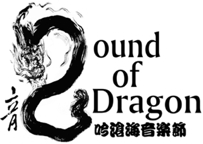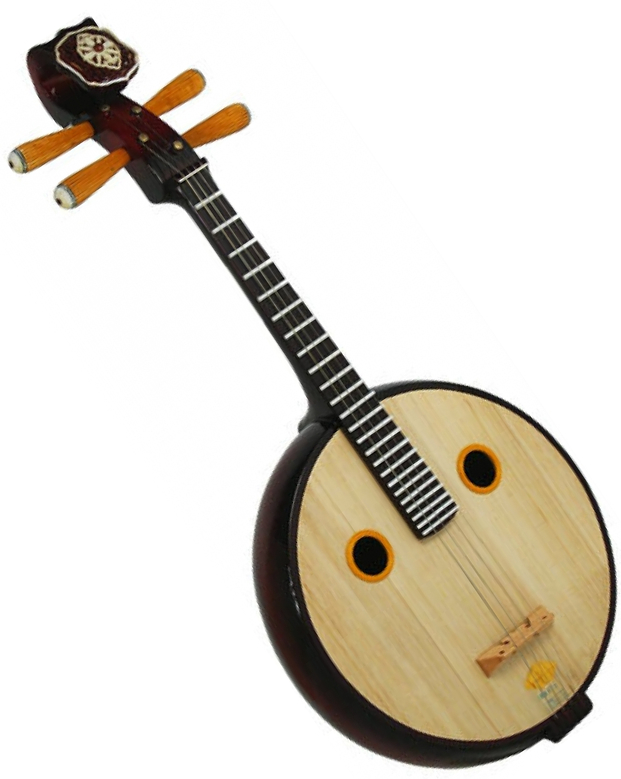
The ruan is an indigenous Chinese plucked string instrument with over 2000 years of history. In the ancient time, ruan was also called qin pipa. The instrument received its present name after the famous player Ruan Xian. By the Tang dynasty (618-907 AD), ruan had become a popular instrument in both court music and folk music. The modern ruan family includes gaoyin ruan (sporano), xiao ruan (small), zhong ruan (medium), da ruan (large), and di ruan (bass). These instruments are constructed almost identically, but in different sizes. Zhong ruan and da ruan are the most common ones, and they are the instruments available in the Sound of Dragon Ensemble.
The ruan has four strings, which are numbered from high to low: 1, 2, 3, 4. The modern’s ruan‘s frets are set in equal temperament to allow the player to modulate to any key.
There are a few different tunings for each size of the ruan. The neighbouring strings are set to either a 4th or 5th apart.



Zhong ruan
Notated in either bass or alto clef, with 24 frets, the zhong ruan’s range spans 3.5 octaves. It is popular both as a solo and ensemble instrument, providing the mid range in ensembles. The first 3 octaves are commonly used in solo repertoire. The first 2.5 octaves are commonly used in ensemble repertoire.
3 different tunings (click to download the pitch charts):
1) G2, D3, G3, D4 (most common) – ranges 3.5 octaves, the highest note is D6
2) A2, D3, A3, D4 – ranges 3.5 octaves, the highest note is D6
3) G2, D3, A3, E4 – ranges 3.5 octaves, the highest note is E6
Da ruan – notated in bass clef; with a larger body, da ruan resonates well and is often used as the bass instrument in ensembles.
3 different tunings are used (click to download the pitch charts):
1) D2, A2, D3, A3 (most common) – ranges 3.5 octaves, the highest note is A5
2) C2, G2, D3, A3 – ranges 3.5 octaves, the highest note is A5
3) D2, G2, D3, G3 – ranges 3.5 octaves, the highest note is G5
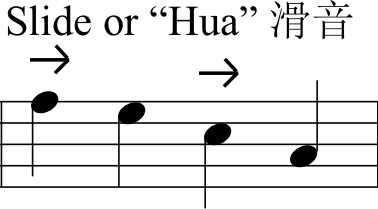
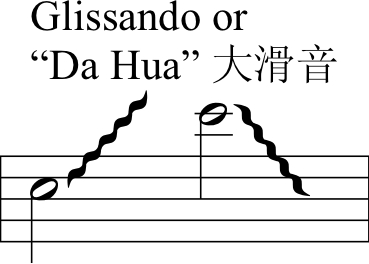
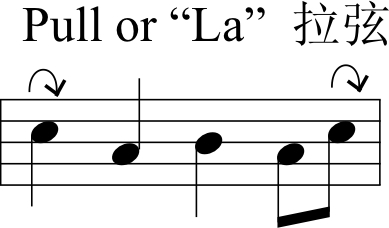

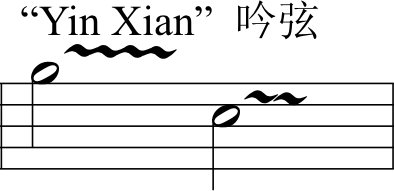
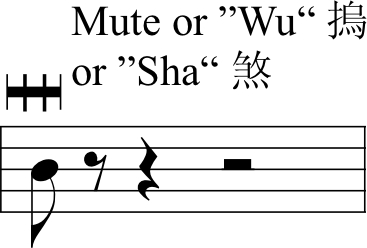
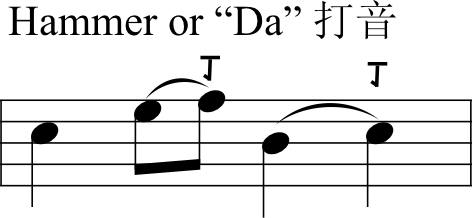

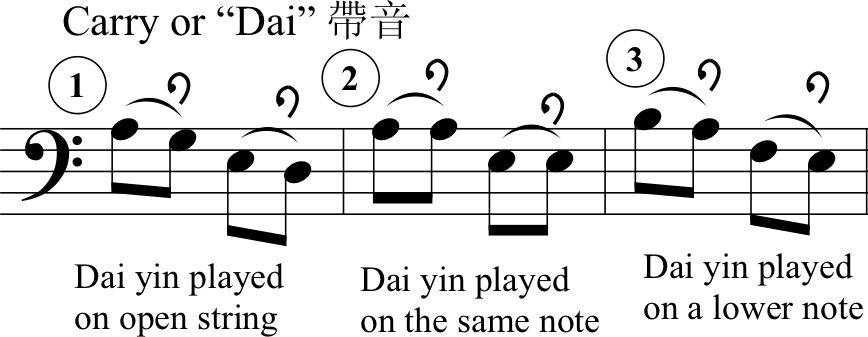
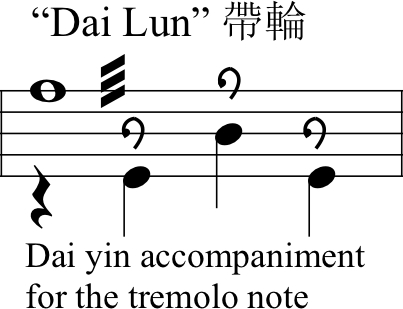
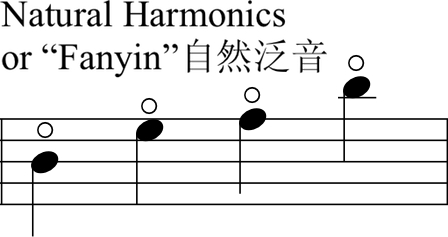
Click to open the chart for Natural Harmonics on Zhong Ruan
Click to open the chart for Natural Harmonics on Da Ruan
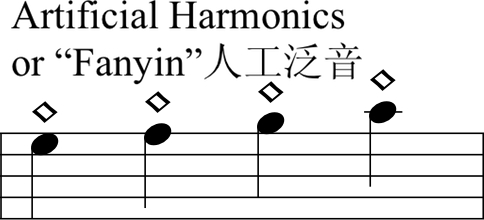
Fingering 指法 - The ruan player uses 4 fingers of the left hand to play the notes, just like the guitarist. The fingers are numbered as 1 (forefinger), 2 (middle finger), 3, and 4 (pinky).
vibrato 揉 - slight shaking on the note with the left hand once the string has been plucked. The player usually plays vibrato automatically in slower tempo. Composers do not need to mark vibrato.
Slide or “Hua Yin” 滑音 -notated as a curved arrow, sliding from one fret to another fret to change the pitch, can be from low to high or from high to low. Hua yin raises the pitch up to a 3rd after a note has just been plucked, without plucking the string again. The speed of slide can be varied depending on the need of the music.
Glissando or “Da Hua Yin” 大滑音 -for intervals wider than a 3rd, use Da Hua Yin. After a note is plucked, lightly touch the string while moving up or down.
Pull or “La” 拉弦 -similar effect to huayin, but not move the finger to different frets. Instead, after plucking the note with the right hand, use the finger (left hand) on the fret to pull the string away from the body to raise the pitch, can be played on string #2, 3, or 4.
Push or “Tui” 推弦 -the note with the right hand,use the finger (left hand) on the fret to push the string closer to the body to raise the pitch, can be used on all of the 4 strings.
Most of the time, La & Tui are combined together. The pitch can be raised to a minor 2nd, Major 2nd, or minor 3rd. Composers do not need to specify whether to use La or Tui.
“Yin Xian” 吟弦 - after plucking a note normally, push or pull the string quickly to the side with the finger on the string to raise the pitch (as in “la” & “tui”), and then return the string back right away to normal to lower the pitch.
Mute or “Wu” 摀 or “Sha” 煞 - uses the palm to cover the strings to stop their vibration after plucking to produce a dry tone.
Hammer or “Da” 打音-notated as 丁, rapidly drop the finger on the fingerboard to create a tone without plucking.
Trill or “Zhi Zhan Yin” 指顫音-notated as tr, continuously hammer a note over the main note.
Carry or “Dai” 帶音 -Pluck the string outward (away from the body) on the fret with the left hand. This technique may be played in different situations, and can be on its own or combined with other techniques.
1) Use any finger of the left hand to press the string and pluck the string with the right hand as you do normally. Then pull that finger (left hand) on the string to the side to pluck the string to produce the pitch of the open string.
2) Press a note with the first finger of the left hand and pluck with the right hand as you do normally. While the 1st finger still holding on the note, pluck the string with the 2nd finger of the left hand to play a “dai yin” on the same pitch to produce different tone colours.
3) Press and play a higher pitch note normally, while holding a lower pitch note on the same string with another finger (left hand). After the higher pitch note is played, pluck the held lower pitch note to produce the sound of the lower pitch.
The tone produced with Da & Dai on the left hand is softer than the regular plucking of the right hand. Pluck, Da, and Dai can be combined together to create contrasting tone colours.
“Sou” 擞音 - notated the same as dai yin over a number of notes. It is a series of “dai yin” played continuously.
“Dai Lun” 帶輪- The right hand plays tremolo on a higher string while the left hand plucks the lower strings to create accompaniment. The left hand may use the 1st finger to press the note and the 2nd & 3rd finger to pluck the lower strings.
Harmonics of Fan Yin 泛音 - The harmonics are produced by lifting the finger of the left hand quickly after plucking with the right hand.
1) Natural harmonics can be produced by taping the strings lightly at 8 different positions on the fingerboard:
string length & fret: 1/4 – 5th fret, 1/3 – 7th fret, 2/5 – 9th fret, 1/2 – 12th fret, 3/5 – 16th fret, 2/3 – 19th fret, 3/4 – 24th fret.
Some of the pitches may be produced at different harmonic points on different strings. The player can choose which string to play depending on the distance to the notes before and after.
2) Artificial harmonics can be produced on any pitch with the combination of two hands. The left hand presses on the string as normal. Use the pinky of the right hand to touch lightly an octave higher on the same string. Then pluck the string with the pick (right hand) above the note the pinky is touching. The harmonics produced is the same pitch as the pressed note. It takes more time to produce artificial harmonics, and therefore, can not change notes too quickly.
Bar chord 橫按 -press all 4 strings on the same fret with one finger flatten on the finger board.
Arpeggio or “Payin” 琶音 - play the 4 strings in this order: #4, 3, 2, 1 . The speed to move between the strings may be uneven, depending on the demand of the music.
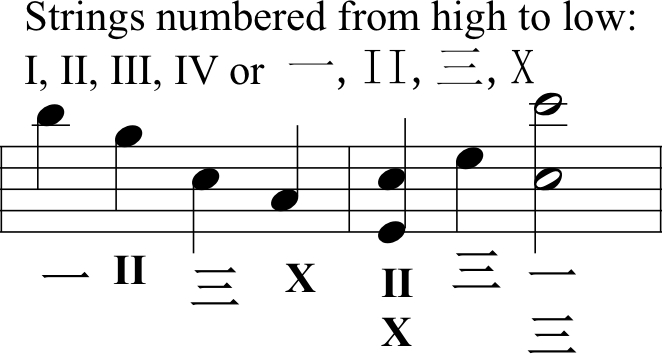
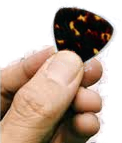

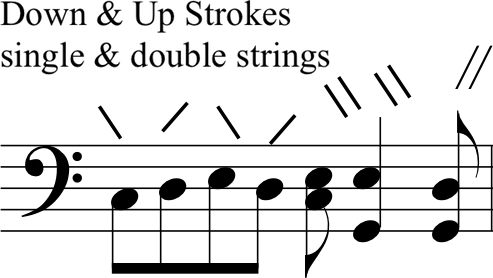

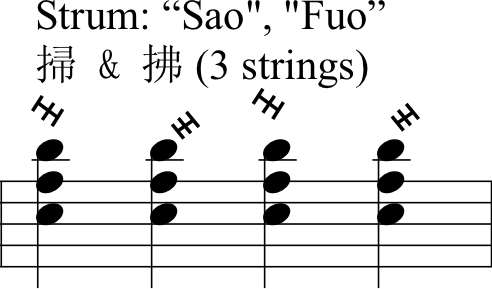
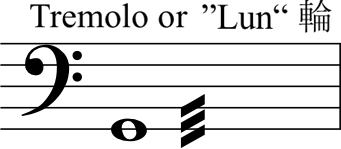
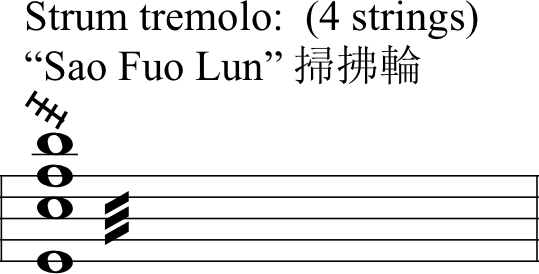
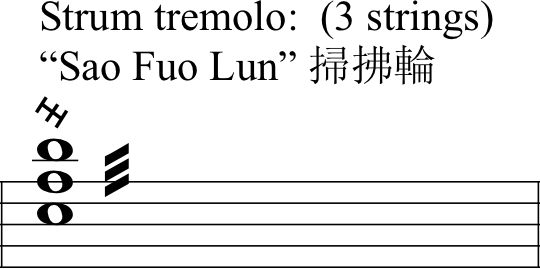

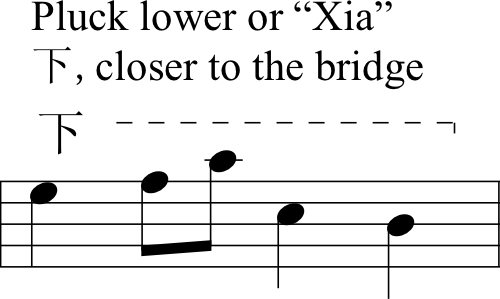
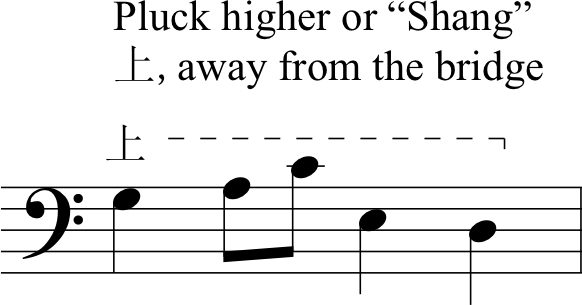
Right Hand Techniques:
The strings are numbered from high to low: I, II, III, IV or 一 II 三 X, notated underneath the notes. If two notes/strings are played simultaneously, write the lower note in the bottom. Most of the time, composers do not need to specify which strings to play. The player will decide based on the convenience of the fingering or the required tone colour. Notes from the 2nd lowest opening string and up may be available on more than one string. The notes played in a higher position and on the lower strings are darker than the same notes played on a higher string. The composer then may want to notate the choice of strings to change the dynamics and tone colour.
Pick – there are two different styles:
1) single pick 彈片-A hard plastic pick held by the thumb and fore finger, very similar to a guitar pick
2) 5 picks (artificial nails)- Many ruan players are also pipa players. They may were pipa picks to play the ruan. There are 5 picks, one on each finger, fixated with surgical tape
Down & Up - Plucking on the ruan can use either down or up stroke. Down stroke is used more often. Traditionally, down stroke, notated as \, is called “tan” 彈; up stroke, notated as /, is called “tiao” 挑. Down and up strokes are controlled by the wrist and supposed to produce the same volume and tone colour. Composers do not need to specify whether to use down or up stroke.
Double Strings -Two adjacent strings can be played almost simultaneously with either down or up stroke to produce harmonies: \\ or //. Composers do not need to specify whether to use down or up stroke.
Strum or “Sao” 掃 -use the forearm to move the wrist to play 3 or 4 strings at the same time with a down stroke. This produces chords and louder volume. The contacting point between the pick and each of the strings should be at the same distance to the bridge to ensure a even tone.
Strum or “Fuo” 拂 - strum 3 or 4 strings with an up stroke. If 3 or 4 notes are notated in the music, the player will automatically use strumming technique. Composers do not need to specify whether to use Sao or Fu.
Repeating the 3 or 4 notes as 8th or 16th notes will require the player to alternate between Sao & Fu continuously, commonly used in dramatic and loud passages.
Tremolo or “Lun” 輪 - alternating rapidly down and up stroke on the same string.
Tremolo & Strum or “Sao Fuo Lun”掃拂輪 - tremolo 3 or 4 strings together.
“Nie” 捏 - is used to play two adjacent strings simultaneously.
“Zhe” 遮 -notated as ( ), it is used play strings #4 & #2 or #3 & #1 simultaneously. It is often used to play 2 notes an octave apart. But it can also be used to play other intervals.
Mute or “Wu” 摀 - uses the palm to cover the strings to stop their vibration after plucking to produce a dry tone.
Down or “xia” 下-notated as “下”, plucking closer to the bridge to produce a brighter tone.
Up or “shang” 上 -notated as “上”, plucking farther away from the bridge to produce a more gentle tone.
If the composer writes the desired dynamics, the player will often choose how far to the bridge to pluck.
“Hua Xian” 滑弦 - similar to arpeggio, but change the strings more evenly in time. Shang Hua Xia 上滑弦 is to play from low to high (string #4 to #1). Xia Hua Xian 下滑弦 is to play from hight to low (string #1 to #4). Alternate Shang Hua Xia & Xia Hua Xian continuously can be used to depict flowing water.
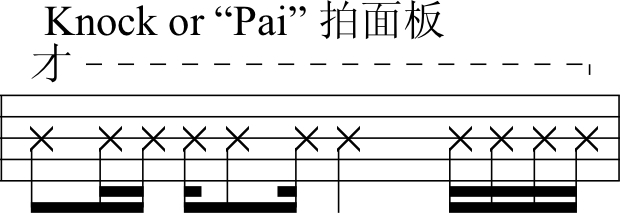
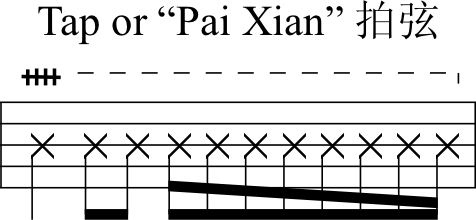
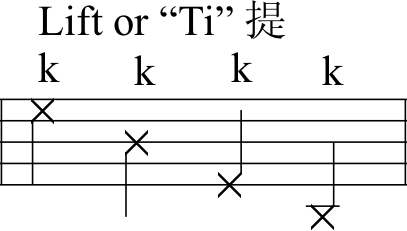
Percussive Sounds:
Knock or “Pai” 拍面板 - Notated as ”才“, knocking on the sound box to produce percussive sound. Both hands may be used. The player can combine two hands together to play like a drummer.
Tap or “Pai Xian” 拍弦 -tap the strings with the right hand to create a percussive sound, no specific pitch.
Lift or “Ti” 提 -Notated as K, lift the string with the right hand, and then release the string to hit the frets to create a percussive sound, no specific pitch.
